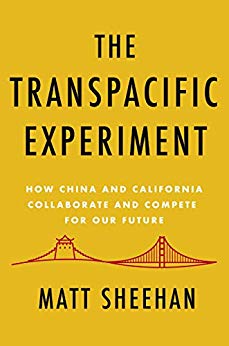
Review of The Transpacific Experiment: How China and California Collaborate and Compete for Our Future, by Matt Sheehan. Counterpoint, 2019.
“To see where the world’s two most powerful countries are meeting, cooperating, and competing today, we need to get outside of Washington, D.C., and Beijing.” Look instead to California. From tech to Hollywood, education to foreign investment, real estate and politics, California is the hub of reciprocal influences that affect and are affected by a rising China more than any other state.
Matt Sheehan, a self-described “journalist, analyst, consultant, and general hanger-on,” captures this “fluid ecosystem of students, entrepreneurs, investors, immigrants, and ideas” in the Transpacific Experiment. Along the way, Sheehan introduces readers to a Beijing tech start-up founded by Chinese returnees from Silicon Valley and rides along with Chinese looking to buy California real estate.
The book’s strongest chapter is its profile of Rex Parris, the mayor of a city in Los Angeles County, and his dogged pursuit of investment from BYD, a Chinese electric vehicle operator. The experience echoes that of the Ohio town captured in the recent documentary, American Factory.
Sheehan consistently excels in capturing the mindsets of a new generation of Chinese who come to America from a country that is “more prosperous, powerful, and stable” than their predecessors, which affects “their motivations to come, their decisions to leave, and their posture towards everything they encounter in America.” What he shows is a California increasingly engaged on China’s terms, that is, a California that is useful to but in many respects ever less influential upon China. Many wealthy Chinese buying Palo Alto real estate aren’t looking for the American dream or democracy; they just want a place to park their wealth.
Other chapters are less richly reported. Sheehan’s look at the surge in Chinese students at California universities, for instance, features the founder of a Chinese-language infotainment site catering to overseas students. Sheehan portrays the site positively, but a closer look might have identified the same concerns about the site’s journalistic practices that the New Yorker has recently raised. In his chapter on the relatively high degree of support for Trump among recent Chinese immigrants, Sheehan recognizes that WeChat is “a digital echo chamber far more insular than anything seen on Facebook or Twitter,” but shines little light on how this fuels misinformation and leaves some of America’s newest citizens vulnerable to manipulation by Beijing’s censors.
Also surprising is the limited attention to how Sacramento is engaging China at a state-level, and the extent to which, when relations are so frayed between the national capitals, this could be good or bad for the country overall. The bad comes from potentially pitting states eager for investment against Washington, which must take into account broader policy considerations. While new governor Gavin Newsom has made international engagement a priority, governors of other states, notably Kentucky, have been more specifically focused on cultivating Chinese investment.
Sheehan does not offer a “precise cost-benefit calculation” for what all of this interaction means, saying that it is too early to tell. It’s a disappointment because his generation is the one that will have to answer the question posed in the book’s opening pages: is America ready to engage with China on equal footing, or even one in which China has the upper hand? The more fundamental question is whether America is willing to defend its values and if it possible to resolve what he calls the dilemma of “messy engagement versus moral high ground”?
While Sheehan has no illusions that China is one of the world’s “most sophisticated authoritarian regimes,” sometimes he seems to place more emphasis on the former adjective instead of the latter. A more forceful conclusion would have made clear that the tremendous mutual gains that have and could yet come from the decades-long transpacific experiment are increasingly unsustainable. Sheehan details the compromises Silicon Valley and Hollywood in particular have been willing to make to enter China’s market, yet fails to conclude that the more influential and more authoritarian China becomes, the more it risks warping ill-prepared free societies in its image.
This moment demands more than observation, no matter how richly rendered, from America’s next generation of China watchers. It requires principled solutions which are regrettably absent here.